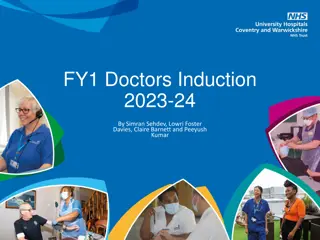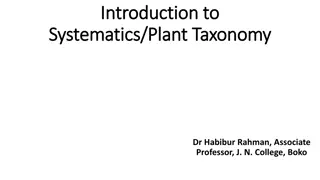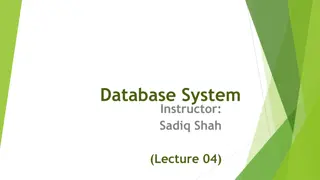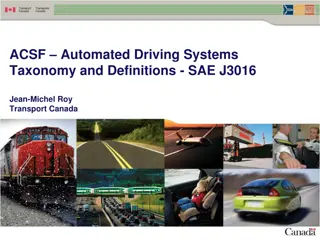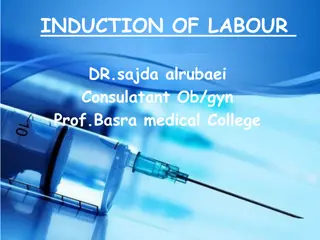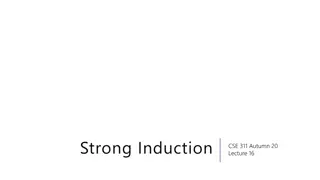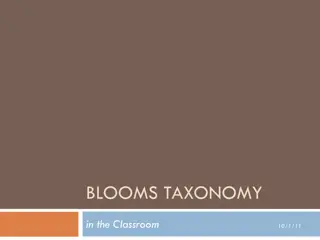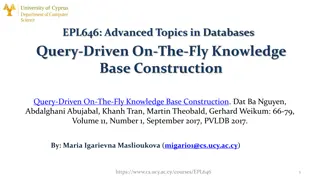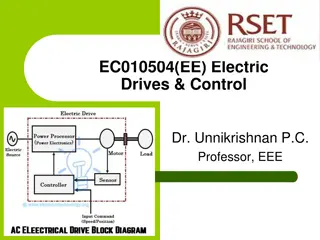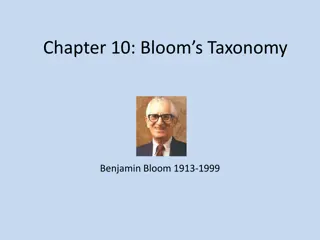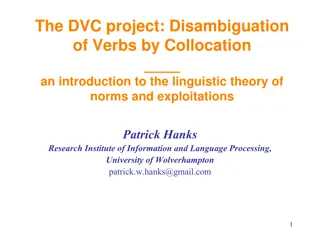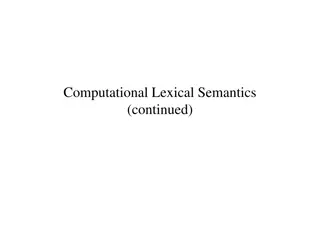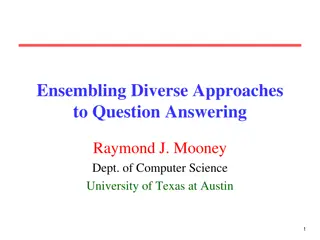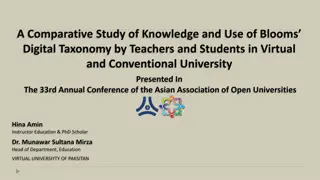Automated Knowledge Base Construction: Taxonomy Induction and Entity Disambiguation Overview
Explore the foundations of automated knowledge base construction through taxonomy induction and entity disambiguation frameworks. Learn about organizing and distinguishing entity types, the significance of structuring entities like physicists, villages, and chemical formulas. Delve into the inputs, methods, and goals of taxonomy induction, with a focus on utilizing hypernymy candidates and candidate cleaning processes.
Uploaded on Sep 25, 2024 | 0 Views
Download Presentation

Please find below an Image/Link to download the presentation.
The content on the website is provided AS IS for your information and personal use only. It may not be sold, licensed, or shared on other websites without obtaining consent from the author. Download presentation by click this link. If you encounter any issues during the download, it is possible that the publisher has removed the file from their server.
E N D
Presentation Transcript
Automated knowledge base construction 4. Taxonomy induction + entity disambiguation Simon Razniewski Summer term 2022 1
Recap Assignment Crawling and scraping Entity types as first building block of KBs Today: How to organize entity types How to distinguish entities 2
Outline 1. Taxonomy induction 2. Entity disambiguation 3
Recap: Entity types Einstein: Physicist, Nobel prize winner, ETH alumni Dudweiler: Village, municipality RCH2OH: chemical formula, psychoactive substance Why organize them? Observations are usually sparse Upper classes may be needed for queries: German locations ending in weiler Scientists born in 1879 Class relations needed for constraint checking graduatedFrom(Person, educationalInstitution) UdS -> University -> OK? 4
Inputs Conversations & Behavior Semi-Structured Data (Infoboxes, Tables, Lists ) Text Documents & Web Pages Web collections (Web crawls) Difficult Text (Books, Interviews ) Premium Sources (Wikipedia, IMDB, ) High-Quality Text (News Articles, Wikipedia ) Queries & Clicks Online Forums & Social Media Logical Inference Rules & Patterns Deep Learning NLP Tools Statistical Inference Methods Entities in Taxonomy Rules & Constraint Relational Statements Canonicalized Statements Entity Names, Aliases & Classes Outputs 5
Taxonomy induction: General approach Hypernymy candidates are cheap Start with large noisy candidate graph, clean it up 7
Candidates #1: Hearst-patterns Hearst-style patterns (here: WebIsALOD for ``Frodo ) 8
Candidates #2: Sub-category relations in Wiki systems 9
Challenges Noise Extraction errors Instances Ambiguous terms Meta-categories Structural oddities Cycles Upward branching Redundancy (transitive edges) Imbalance in observations and scoring Naive thresholding discards entire regions 10
Text-based taxonomy induction challenge [Semeval 2016, Bordea et al.] Input: Set of domain terms Tofu, pizza, garlic Computer, smartphone, printer Task: Induce a taxonomy over these terms Evaluation measures Recall w.r.t. gold standard Precision w.r.t. gold standard Connectedness (#connected components) Categorization (#intermediate nodes) Acyclicity #nodes #edges 11
Taxi [Panchenko et al., 2016] 1. Crawl domain-specific text corpora in addition to WP, Commoncrawl 2. Candidate hypernymy extraction 1. Via substrings biomedical science isA science microbiology isA biology toast with bacon isA toast Lemmatization, simple modifier processing Scoring proportional to relative overlap 2. Candidate hypernymy from 4 Hearst-Pattern extraction projects 3. Supervised pruning 1. Positive examples: gold data 2. Negative examples: inverted hypernyms + siblings 3. Features: Substring overlap, Hearst confidence (more features did not help) 12
Taxi [Panchenko et al., 2016] 4. Taxonomy induction Break cycles by random edge removal Fix disconnected components by attaching each node with zero out-degree to root - too many hypernyms in English 13
Taxonomy induction using hypernym subsequences [Gupta et al., 2017] Looking at edges in isolation ignores important interactions Hypernym candidates typically contain higher-level terms that help in predicting whole sequence Crucial as abstract term hypernym extraction empirically harder (e.g., company group of friends ?) 14
Taxonomy induction using hypernym subsequences [Gupta et al., 2017] Joint probabilistic model that estimates true hypernymy relations from skewed observations Break cycles by removing edges with minimal weight Induce tree from DAG by a min-cost-flow model 15
Taxonomy induction using hypernym subsequences [Gupta et al., 2017] Method: Find cheapest way to send flow from leaves to root Cost inversely proportional to edge weight 16
Wiki[pedia | a]- based taxonomy induction: TiFi [Chu et al., WWW 2019] Observations: Wikia category systems are noisy Wikia category systems lack abstractions Approach: Supervised filtering + WordNet reuse 17
TiFi: Category cleaning Challenge: Meta-categories (Meta, Administration, Article_Templates) Contextual categories (actors, awards, inspirations) Instances (Arda, Mordor) Extensions (Fan fiction) Approach: Supervised classification Featurizes earlier rule-based category cleaning works, e.g., [Pasca, WWW 2018] Features: Lexical Headword in plural? Dark Orcs, Ring of Power Capitalization? Quenya words, Ring bearers Graph-based #instances Supercategory/subcategory count Average depth Connected subgraph size 18
TiFi: Category cleaning - results Most important feature: Plural Occasional errors (Food) 19
TiFi: Edge cleaning Challenge: Topical mismatches Frodo The Shire Boromir Death in Battle Chieftains of the D nedain D nedain of the North Approach: Supervised classification Combination of lexical, semantic and graph-based features 20
TiFi: Edge cleaning - features Lexical Head word generalization (c sub??????? d?) - ??? ? + ???? ? = ???(?) + ????(?) and ??? ? ?? ???(?) Dwarven Realms Realms - ??? ? + ??? ? = ??? ? + ???(?) and ???? ? ?? ???? ? Elves of Gondolin Elves Only plural parents? Semantic WordNet hypernym relation? Wikidata hypernym relation? Text matches Wikia first sentence Hearst match Haradrim: The Haradrim, known in Westron as the Southrons, were a race of Men from Harad in the region of Middle-earth. WordNet synset description headword Ex: Werewolves: a monster able to change appearance from human to wolf and back again Distributional similarity WordNet graph distance (Wu-Palmer score) Directional embedding scores (HyperVec directional interpretation of embeddings) Distributional inclusion hypothesis: flap is more similar to bird than to animal Hypernyms occur in more general contexts Graph-based #common children Parent.#children/parent.avg-depth 21
TiFi: Edge cleaning - results Embedding only Rules only Most important features: Only plural parent Lexical generalization Common child support Wikia first sentence Hearst match 23
TiFi: Top-level construction Problem: Wikia categories represent many disconnected components Solution: Link sinks to WordNet taxonomy and import further top level 24
TiFi Top-level construction Using latent similarity based on description and parent/child names versus WordNet glosses Birds is mapped to bird%1:05:00:: Subsequent hypernyms: wn_vertebrate wn_chordate wn_animal wn_organism wn_living_thing wn_whole wn_object wn_physical_entity wn_entity Removal of long paths (nodes with only one child and one parent) Dictionary-based filtering of ~100 too abstract classes (whole, sphere, imagination, ) 25
Open: Taxonomy Merging ~Complex alignment problem requiring joint optimization 28
Summary: Taxonomy induction Usually a filtering process on larger candidate set Structure matters for local decisions Local-only decision OK but not optimal Top-level: Avoid reinventing wheel Sparse observations Generality makes reuse easier Relevance for AKBC: Queries for type conditions not explicitly observed Constraints on relation arguments 29
Outline 1. Taxonomy induction 2. Entity disambiguation 30
Ready for fact extraction? Homer is the main character Homer is the author of the of the TV series Simpsons . Odyssey. appearsIn(Homer, Simpsons) wrote(Homer, Odyssey)? 31
Inputs Conversations & Behavior Semi-Structured Data (Infoboxes, Tables, Lists ) Text Documents & Web Pages Web collections (Web crawls) Difficult Text (Books, Interviews ) Premium Sources (Wikipedia, IMDB, ) High-Quality Text (News Articles, Wikipedia ) Queries & Clicks Online Forums & Social Media Logical Inference Rules & Patterns Deep Learning NLP Tools Statistical Inference Methods Entities in Taxonomy Rules & Constraint Relational Statements Canonicalized Statements Entity Names, Aliases & Classes Outputs 32
Also called Wikification, because everyone links to Wiki[pedia | data] 34
Who wins? 37
Can be computed e.g. from Wiki[pedia | a] by link disambiguation or page views 39
Local or global solution? Features so far local (one entity mention at a time) Context-similarity Disambiguation prior Do disambiguations influence each other? 40
Possible implementation (2) n entity mentions Each with m candidate KB entities Compute coherence scores for mn combinations 42
Possible implementation (2) [Guo and Barbosa. Robust Named Entity Disambiguation with Random Walks, SWJ 2018] 43
State of the art Pre-trained neural models for context match likelihood Encode KB context Encode text context Predict match likelihood or, predict KB identifier directly (GENRE, de Cao, ICLR 2021) Graph algorithm for global coherence Automated training data: Wikipedia-data text links 44
Example systems (1): Opentapioca https://opentapioca.org/ https://arxiv.org/pdf/1904.09131.pdf 45
Example systems (2): AIDA Explicit parameter tuning no more functioning https://gate.d5.mpi-inf.mpg.de/webaida/ 46
Further solutions spaCy can do this https://spacy.io/usage/linguistic-features#entity-linking Though more complex setup, KB Commercial APIs https://try.rosette.com/ https://cloud.google.com/natural- language/docs/analyzing-entities https://azure.microsoft.com/en-us/services/cognitive- services/text-analytics/ 47
Disambiguation vs. typing Like for typing, context is decisive Unlike typing, no chance for supervised approach Can train classifiers that predict Politician-ness of a mention Cannot train classifier to predict Einstein-ness Disambiguation is ranking problem (single solution), not multiclass classification Type predictions can be used as intermediate features for context-based disambiguation Type prediction can augment disambiguation, if KB has sparse content 49
References Panchenko, Alexander, et al. Taxi at SEMEVAL-2016 Task 13: A taxonomy induction method based on lexico-syntactic patterns, substrings and focused crawling. SemEval 2016. Gupta, Amit, et al. "Taxonomy induction using hypernym subsequences." CIKM 2017. Chu, Cuong Xuan, et al. "TiFi: Taxonomy Induction for Fictional Domains." WWW 2019. Yosef, Mohamed Amir, et al. Aida: An online tool for accurate disambiguation of named entities in text and tables. VLDB 2011. Slides adapted from Fabian Suchanek, Gina-Anne Levow and Chris Manning 50





